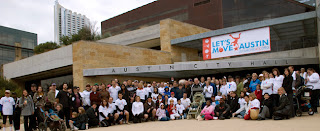As I sat down on the couch to put off digging out warm running clothes and my training for my second half marathon, I thought I would use this time to catch up on my blog and write about running instead of actually doing it, for now. It’s a solid training method.
 |
Team Texas Fight returns to fundraising and training for the 2012 LIVESTRONG Austin Half Marathon. My LIVESTRONG donation page is up and running – if you’re interested in learning more about my team’s fight against cancer, check it out. Go Texas Fight!
|
I haven’t blogged in a while, but even tips from my post about running in the Texas heat could not have convinced me to fight the impossibly hellish temperatures this summer. Austin broke a record for being 100 degrees Fahrenheit or more for 90 consecutive days. Long story short, I was forced to join a gym for the benefits of air conditioning and actually ended up enjoying the variety of workouts.
But that’s all behind us now -- it’s a cool 50 degrees outside and I have no excuse except the Halloween candy I just indulged in for not getting in gear. As long as I’m procrastinating my run, I’ll lay out my training and motivation plan leading up to the February 19 race day. Maybe that will motivate me.
Running for a reason – make a plan and stick to it
I don’t have too flexible of a schedule for spontaneous runs, and I doubt many people do. My advice to busy runners and fitness junkies is to not be overly ambitious in scheduling workouts. Plan for times you know you’ll be able to commit to. I know I can’t, for example, hit the road after coming home from dinner with friends or after half an hour of a post-work couch session. I have to get my runs done in the morning, and I enjoy starting my day off with a workout anyway.
Planning ahead, rewarding yourself (someone come try a tableside s’more at Halcyon’s with me) and changing up your routine are some of my favorite of the 20 ways Women’s Health Magazine says will help you stick to your schedule. The list comes in handy; there are just some days you’d rather adopt Madagascar cock roaches as pets than get up and work out. Unless you’re into that kind of thing.
My plan
My goal is to start incorporating speed work into my training. As this is my second half marathon, I want to cross the finish line in two hours or less. I’ll go into a more detail about training for specific time goals when I have more experience, but this Runner’s World list lays out all kinds of training plans if you want to get started now. For now, I’m running four to five times a week, including three to four 4-mile runs and a long run on the weekend, which will progress from five to 10 miles as it gets closer to the race.
Are you training or fundraising for any runs, walks, rides or other random fitness events? Austin zombie run in 2012 anyone? Let me know your plan!
| Undead participants in the 2011 Run For Your Lives 5k. Happy Halloween! From runforyourlives.com |



